You’ve likely heard that finding the right bait can make or break your catfishing success, but with so many options, how do you choose the best one? Whether considering natural baits like nightcrawlers and shad or leaning towards prepared options such as Magic Bait, each type has unique advantages depending on the catfish species and water conditions you’re dealing with. However, there’s more to this than just picking a bait; understanding the behavior and habitat of catfish can greatly enhance your strategy. Let’s explore how to use this knowledge to select the most effective bait for your next fishing adventure.
Key Takeaways
- Natural baits like nightcrawlers and gizzard shad effectively attract channel and blue catfish, respectively.
- Prepared baits such as Magic Bait and Power Bait are formulated to appeal to catfish in various water conditions.
- Cut bait from fish like white suckers works well in colder regions for attracting catfish.
- Artificial lures with realistic swimming action and scents can also be effective, especially in clear water.
- Stink baits and chicken livers are highly effective for catfish due to their strong odors, which appeal to their keen sense of smell.
Natural Baits for Catfish
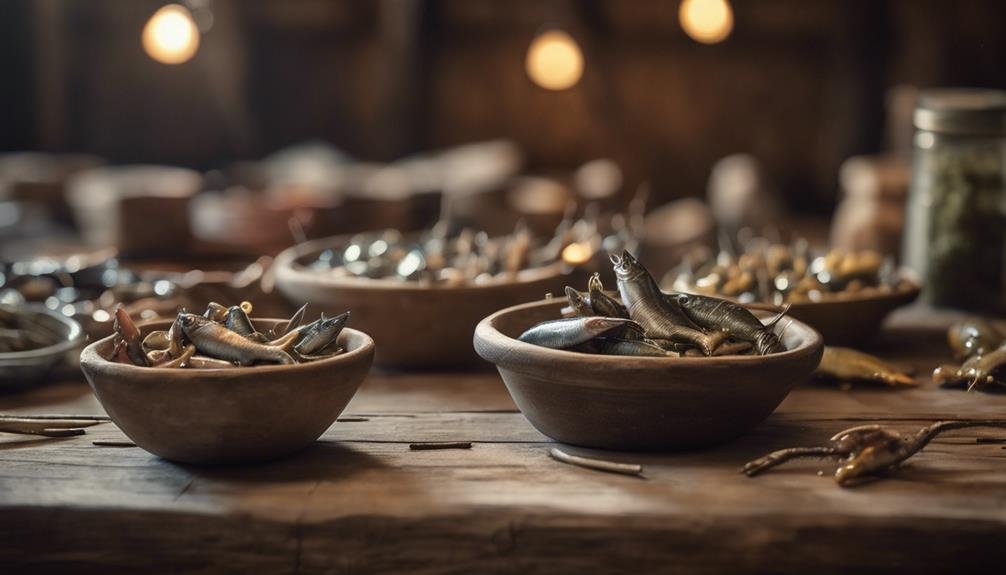
When targeting catfish, natural baits like nightcrawlers often yield the best results. A nightcrawler is a top choice, particularly effective for channel catfish. This natural bait attracts catfish species, including bullheads and white catfish, making it a versatile option in your angling arsenal.
Don’t overlook gizzard shad either; it’s a favorite among catfish anglers. This bait is particularly effective for blue catfish and giant flatheads, offering you a chance at those bigger, more elusive catches. Whether you use it as a cut or live bait, gizzard shad is a must-have for serious catfish hunters.
Moving to colder regions, white suckers become a prime option. These are available mostly in the Midwest and are excellent for creating irresistible cut-bait chunks. You can also keep them alive as live bait, enhancing their effectiveness.
For those chasing trophy-size catfish, skipjack herring should be on your radar. Ideal for attracting giant blues and channel cats, Skipjack Herring is a top-tier choice.
Lastly, if you’re in an area with invasive species, consider using Asian carp. Surprisingly effective, they can attract bighead catfish and help you effortlessly tackle larger specimens.
Popular Prepared Baits
For catfish enthusiasts, prepared baits like Magic Bait and Power Bait offer a convenient and effective option. These products and others, such as Shad and Spanish catfish nuggets, are readily available at Walmart. What makes these baits so appealing is their variety of textures and scents, designed to attract different types of catfish. Whether you’re fishing in murky river waters or clear lakes, these baits are formulated to catch the olfactory attention of catfish, enticing them to bite.
You can experiment with these options to determine what works best under local fishing conditions. It’s all about finding the right combination that is effective for the catfish in your area. This approach simplifies your bait selection process and allows you to focus more on refining your fishing techniques rather than worrying about bait preparation.
Next time you’re gearing up for a day of catfishing, consider grabbing a pack of Magic Bait or Power Bait. You might find that these prepared baits, with their enticing scents and appealing textures, are exactly what you need to reel in a big catch.
Effective Artificial Lures
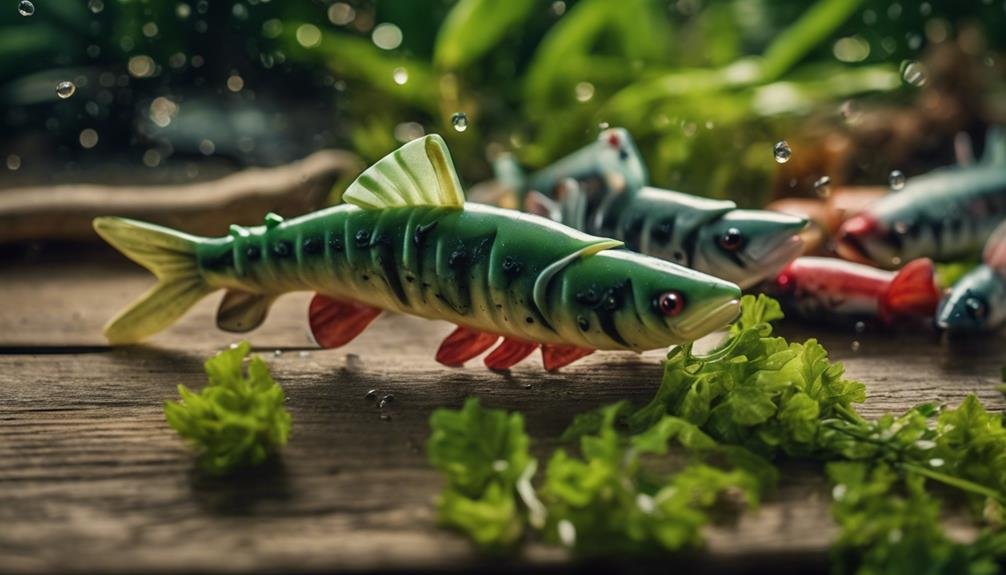
Switching to artificial lures, such as plastic worms and crankbaits, can greatly enhance your catfish-catching success. When targeting catfish, using lures that mimic their natural prey could be the key to provoking those aggressive strikes you’re after. Plastic worms and swimbaits designed in natural colors like green, pumpkin, or black have shown excellent results. These colors blend well in various aquatic environments, making them irresistible to cautious catfish.
Moreover, incorporating lures like lipless crankbaits that feature rattles can be a game-changer. These lures produce vibrations and sounds that mimic distressed prey, tapping into the catfish’s keen sense of hearing and vibration detection. This can often lead them directly to your hook, even in murkier waters where visibility is low.
It’s also wise to select lures that offer a realistic swimming action. Catfish are particularly drawn to this movement, as it simulates live prey. Some artificial lures are even enhanced with scent, adding an extra layer of attraction that can coax more skeptical fish into biting. This realistic action and enticing scent combination create a potent setup that could significantly enhance your catfish haul.
Catfish Behavior Insights
Understanding how catfish behave and where they prefer to live can greatly enhance your bait selection and fishing outcomes. Channel catfish and blue catfish, two common species, have different feeding behaviors that you’ll want to consider.
Channel catfish are known as opportunistic feeders. They aren’t picky, so various natural baits like worms, crayfish, and insects work well. On the other hand, blue catfish primarily hunt forage fish like shad, making them more likely to strike live baits that mimic their natural prey.
Catfish’s keen sense of smell makes stink baits and chicken livers especially effective. These baits emit strong odors that catfish can detect from great distances, drawing them to your hook.
When choosing the best catfish bait, consider both prepared and natural bait. Prepared baits are convenient and often designed to target catfish’s olfactory senses, while natural baits can be more appealing due to their authenticity.
Ideal Catfish Habitats
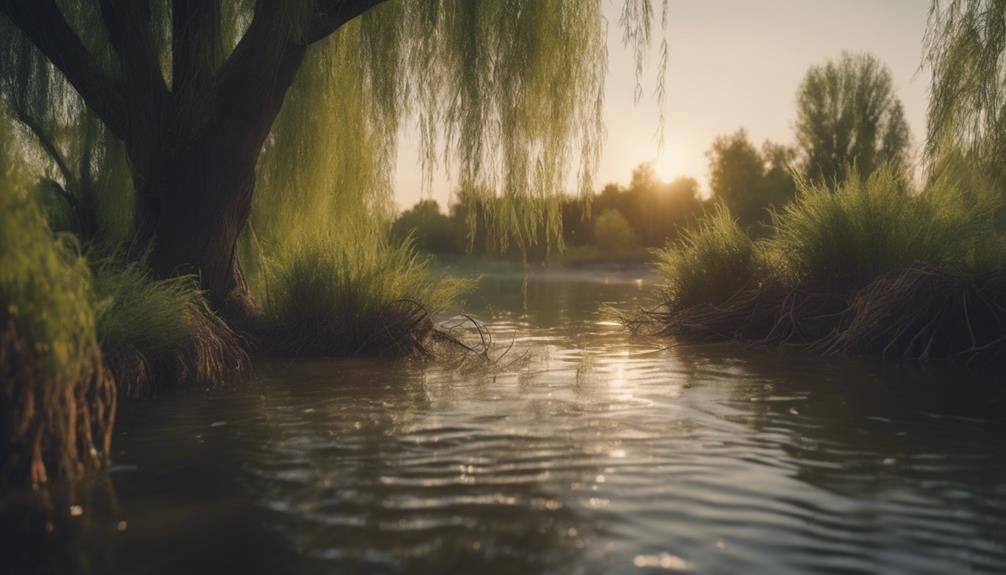
Channel catfish thrive in various settings, including rivers, lakes, and ponds, adapting well to different water conditions. As you search for the perfect spot to cast your line, remember that the best catfish baits mimic their natural forage. Blue catfish, for instance, are often found in deeper parts of large rivers or reservoirs, where baitfish are plentiful. Flathead catfish, with their unique ability to taste through their skin, prefer clearer streams or ponds where they can easily detect a scent trail.
When selecting your fishing spot, consider these factors to increase your chances of a successful catch:
- Availability of natural forage: Areas rich in bait fish attract more catfish.
- Water clarity and depth: Murky river water is perfect for channel catfish, while deeper spots suit blue catfish.
- Access to bait shops: Make sure you’re near shops where you can replenish supplies like live bait and punch baits.
Seasonal Fishing Patterns
As seasons change, so do catfish habits, making it important to adjust your fishing strategies accordingly. Understanding these seasonal patterns is key to selecting the right bait and improving your catch rate.
As water temperatures rise in spring, catfish move to shallower waters to spawn. This is your chance to catch them more easily, as they’re accessible and active. Use baits that mimic their natural food sources, which are plentiful during this time.
Come summer, the heat drives catfish to cooler, deeper waters. You’ll need to adapt your fishing tactics, opting for baits that can reach these depths and attract less active fish. Look for areas with structured hiding spots where catfish might retreat from the heat.
As they prepare for the colder months, fall triggers a feeding frenzy in catfish. They become highly active, and your bait choices should be aggressive and appealing to capitalize on this increased activity.
Winter presents the biggest challenge. Catfish’s metabolism slows drastically, making them less active and harder to tempt. This is when your bait choice becomes vital. Opt for irresistible scents and flavors, even to the sluggish winter catfish, and be patient as they take longer to respond.
Bait Presentation Techniques
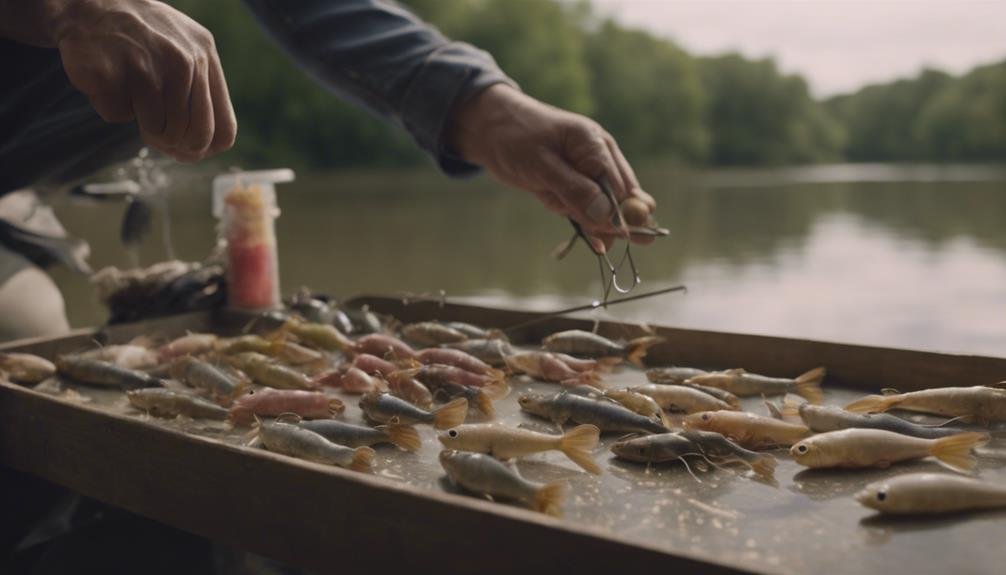
To effectively attract catfish, you must master various bait presentation techniques that guarantee your bait mimics natural prey movements and appearances. Understanding how to size and use cut bait appropriately, applying rigs specifically designed for stink and dough baits, and leveraging the dissolving properties of dough baits are critical. Each species and differing water conditions may require tailored approaches to maximize your success.
Here’s why these techniques matter deeply:
- Natural Movement: Ensuring your bait moves like real prey in the water sparks the predatory instincts of catfish, compelling them to strike with vigor.
- Adaptability: Adjusting your presentation based on water temperature and season, like using scented baits in colder waters or engaging in night fishing during warmer months, keeps you versatile and effective.
- Precision: Properly rigged baits reduce the risk of losing them and increase the chances of a successful catch, making every fishing trip worthwhile.
Bottom Fishing Strategies
Bottom fishing is a highly effective strategy targeting catfish as it places the bait right where these fish are most likely to feed. This method allows you to exploit their feeding habits by presenting bait directly on or near the riverbed. Utilizing heavy sinkers, you’ll guarantee your bait stays grounded despite any currents that might otherwise sweep it away.
One popular bottom-fishing technique is tightening, where you keep the line taut, allowing you to feel even the slightest nibble from a catfish. This method is essential because catfish often suck in bait rather delicately.
Another effective technique is using a slip sinker rig. This setup involves a weight that slides on the line, allowing catfish to move with the bait without detecting resistance. This can lead to a more natural bait presentation, increasing your chances of hooking a wary fish.
Drift Fishing Methods
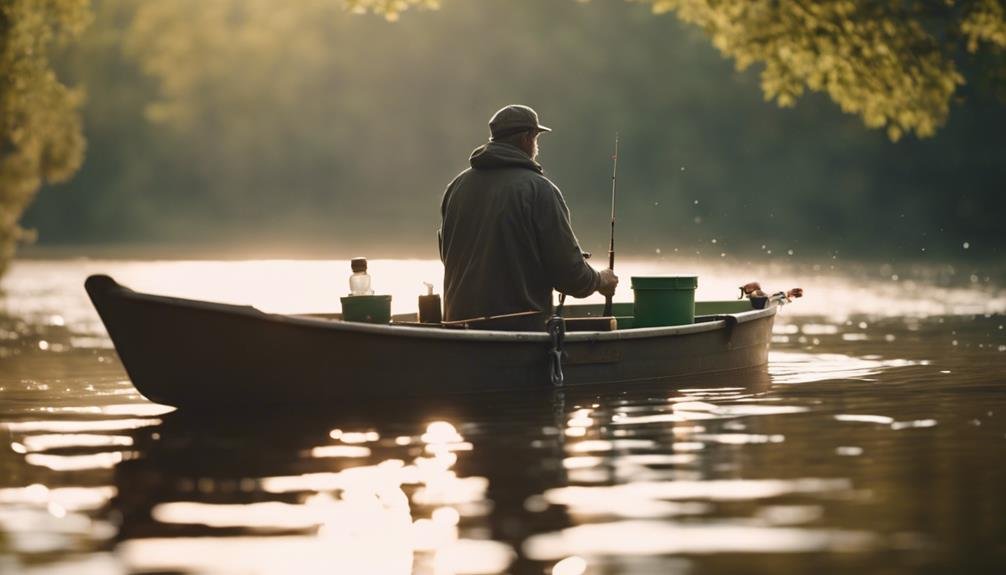
Drift fishing lets you cover more water by letting your bait travel naturally with the current, making it an excellent method for catching active catfish. Using your boat, you can skillfully control the speed and direction of your drift, ensuring your baits are presented enticingly in the flowing waters. This technique is particularly effective for channel and blue catfish, known for their preference for chasing down moving prey.
When selecting baits for drift fishing, consider the variety of options available:
- Natural Baits: Fresh-cut baits like shad or carp can emit potent scents that draw catfish even from a distance.
- Artificial Baits: Don’t overlook synthetic options that mimic the movement and texture of real prey and are adaptable to various water conditions.
- Combination Tactics: Sometimes, mixing natural and artificial baits can create an irresistible lure for those stubborn catfish.
Jug Fishing Tips
Jug fishing effectively covers a vast area of water, increasing your chances of catching catfish efficiently. This method employs floating jugs or bottles as indicators for when catfish bites occur. You’ll attach lines with hooks to these jugs, baiting them with your chosen bait options. It’s an effective technique because you’re not confined to a single spot but can spread your baits across a broader expanse.
The key to jug fishing success is monitoring jug movements. Keep an eye on the floating jugs—any sudden or unusual movement can signal that a catfish has taken the bait. This method maximizes your fishing area and enhances your ability to constantly detect bites without holding a rod.
Make sure your hooks are well-baited with enticing bait options. Effective baiting is essential if you prefer natural baits like worms and minnows or concocted baits specifically made for catfish. Remember, the choice of bait can greatly influence your success rate in jug fishing. Covering a larger area with well-prepared floating jugs sets you up for a fruitful fishing outing.
Conclusion
When aiming to hook a catfish, you have a variety of baits to choose from. Whether you go natural with nightcrawlers and shad, opt for convenience with prepared baits like Magic Bait, or try artificial lures that mimic live prey, your success hinges on understanding catfish behaviors and habitats.
Experiment with different baits and techniques, such as bottom and drift fishing, to improve your chances of catching these crafty fish. Remember to adjust your approach based on their natural environment!
FAQs
What are some of the best baits for catching catfish?
Some of the best baits for catching catfish include live bait like nightcrawlers, minnows, and shad and prepared baits like chicken liver, stink bait, and dough balls. Each bait type has its advantages, with live bait being particularly effective for larger catfish and prepared bait being convenient and readily available.
How do I choose the right bait for catfishing?
Choosing the right bait for catfishing depends on several factors, including the type of catfish you are targeting, the water conditions, and personal preferences. Live baits are generally more appealing to larger catfish, while prepared baits like stink bait can be more effective in murky waters. Experimenting with different baits can help determine what works best in your fishing spot.
Can homemade baits be effective for catching catfish?
Yes, homemade baits can be very effective for catching catfish. Common homemade bait recipes include cheese, dough, and various meats. The key is to create a strong scent of bait catfish. Many anglers find success with their custom bait recipes, which can be both fun and cost-effective compared to store-bought options.

